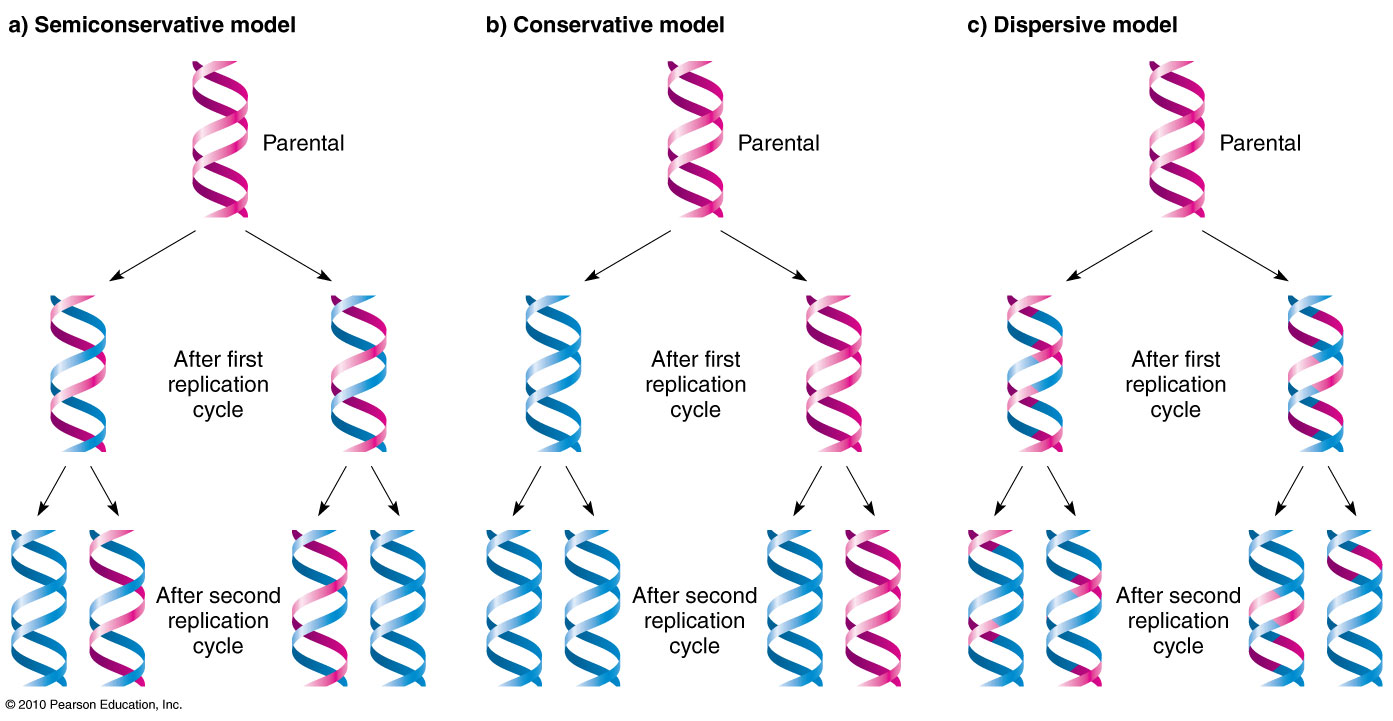DNA carries the information for making all of the cell's proteins. These
proteins achieve all of the functions of a living organism and define the organism's characteristics. When the cell reproduces, it
has to pass all of this information to the daughter cells.
Before a cell can reproduce, it must first replicate its DNA.
DNA replication:
is a biological process that occurs in all of living organisms making an exact
copy of a section of duplex (double-stranded) DNA, using existing
DNA as a template for the synthesis of new DNA strands.
DNA replication occurs in the cytoplasm of prokaryotes and in the nucleus of eukaryotes.
- How DNA
Makes Copies of Itself ..
Before replication can occur, the length of the DNA
double helix about to be copied must be unwound by helicase enzyme.
In addition, the two strands must be separated by breaking the weak hydrogen bonds that link the paired bases.
The initiation point where the splitting starts is called origin of replication.
In addition, the two strands must be separated by breaking the weak hydrogen bonds that link the paired bases.
The initiation point where the splitting starts is called origin of replication.
Once the DNA strands have been unwound, they must be held apart to expose the bases so that new nucleotide partners can hydrogen-bond to them.
Single-strand binding proteins 'SSBs', do not allow the two strands to join back together.
RNA primase binds at the initiation point of the 3′-5′ parent chain. RNA primase synthesize first nucleotide of the new strand.
It attracts RNA nucleotides which bind to the DNA nucleotides of the 3′-5′ strand with hydrogen bonds between the bases.
Here, free 3′ OH group of previous nucleotide get attached with the one phosphate group. Energy is released when the bond of that phosphate group with other two is broken; this energy is used for polymerisation , process of formation of new strands.
An enzyme complex called DNA polymerase walks down the DNA strands and joins newly arrived nucleotides into The daughter strand that is complementary to the template.
The nucleotides pair with the complementary nucleotides on the existing stand (A with T, G with C).
The elongation process is different for the 5′-3′ and 3′-5′ template.
5′-3′ Template –The daughter strand proceeding in 3′-5′ direction, uses a 5′-3′ template. This strand is called as leading strand because DNA polymerase delta can read the template and continuously adds complementary nucleotides (like Adenine opposite to Thymine).
3′-5′Template – DNA polymerase delta can not read 3′-5′ template. The daughter strand using this template for elongation is called as lagging strand. It grows discontinuously away from the replication fork. In the lagging strand the DNA polymerase epsilon reads the template. First RNA primase adds a section of RNA primer; the DNA polymerase I (Exonuclease) reads the fragments and removes the RNA Primers. For more lagging strand building, helix must continue to unwind. Thus, lagging strand is built discontinuously. The gap between two RNA primers is called as Okazaki Fragments. The gaps are closed with the action of DNA polymerase by adding complementary nucleotides to the gaps and DNA Ligase by addition of phosphate in the remaining gaps of the phosphate – sugar backbone.
When the DNA polymerase reaches to an end of the strands termination occurs. The RNA primer is removed; DNA polymerase could not to seal the gap as there is no primer. So, the end of the parental strand where the last primer binds is not replicated. This end of linear DNA consists of non-coding DNA that contains repeat sequences. It is called as telomere. As a result, a part of the telomere is removed in every cycle of DNA replication.
Mechanism of repair fixes possible errors caused during the replication process. Enzymes like nucleases remove the wrong nucleotides and the DNA polymerase fills the gaps.
In the entire replication bubble, leading and lagging strands work in opposite directions.
Same happens in the other replication bubbles. The process of formation of leading and lagging strands continues in both the directions until the entire DNA molecule has been replicated.
As we know, there are many replication bubbles along the length of DNA, these replication bubbles continue to grow until they join together.
Models of DNA replication
- Semi conservative
- Conservative
- Dispersive
Semi conservative Replication:
Each of two daughter helices conserves only one of the parental
strands hence the process is called as semi conservative replication.
Conservative Replication:
Both strands of the new DNA molecule are newly synthesized strands; both strands of the parental DNA are conserved.
Dispersive Replication:
In this model there is fragmentation of parental strand and
intermixing of pieces of parent helix with newly synthesized pieces to
form new daughter molecule.
The correct model is the first. Semiconservative DNA Replication was proved by the experiment of Meselson – Stahl.








0 التعليقات:
Post a Comment